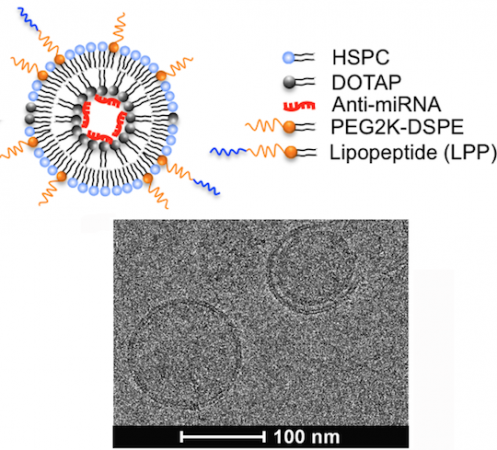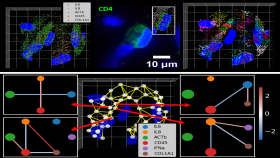The potential of a gene-silencing technique called RNA interference has long enticed biotechnology researchers. It’s used routinely in the laboratory to shut down specific genes in cells. Still, the challenge of delivery has held back RNA-based drugs in treating human disease.
RNA is unstable and cumbersome, and just getting it into the body without having it break down is difficult. Once that hurdle is met, there is another: the vast majority of the drug is taken up by the liver. Many current RNA-based approaches turn this apparent bug into a strength, because they seek to treat liver diseases.
But what if you need to deliver RNA somewhere besides the liver?
Biomedical engineer Hanjoong Jo’s lab at Emory/Georgia Tech, working with Katherine Ferrara’s group at UC Davis, has developed technology to broaden the liver-dominant properties of RNA-based drugs.
The results were recently published in ACS Nano. The researchers show they can selectively target an anti-microRNA agent to inflamed blood vessels in mice while avoiding other tissues.
“We have solved a major obstacle of using anti-miRNA as a therapeutic by being able to do a targeted delivery to only inflamed endothelial cells while all other tissues examined, including liver, lung, kidney, blood cells, spleen, etc. showed no detectable side-effects,” Jo says.
Research by Jo’s lab, published in 2013 in Nature Communications, had established that microRNA 712 was a master controller of inflammation in atherosclerosis.
In the Nature Communications paper, an antisense molecule that counteracts miRNA 712 can stop the effects of high fat diet and disturbed blood flow in the atherosclerosis model. It reaches the desired cells: endothelial cells, which line blood vessels. But the anti-miRNA has significant effects on the liver and blood cells at the same time.
To restrict delivery of an antisense molecule countering miRNA 712 to endothelial cells, the authors built nanoparticles with several layers. Inside was the payload: the anti-miRNA, packaged with a positively charged lipid. Around that is a neutral coating, decorated with a peptide that targets the inflammatory molecule vascular cell adhesion molecule 1. The same peptide has previously been tested as a potential cardiovascular imaging tool.
The resulting multi-layer package was delivered selectively to only the inflamed endothelial cells, the authors show in the ACS Nano paper. In the atherosclerosis mouse model, it was possible to use five times less than the “naked” untargeted version and still see beneficial effects.
The multi-layer packaging method could easily be adapted to other miRNAs, such as the human equivalent miR-205, in the context of treating atherosclerosis. However, using other targeting peptides, with the goal of reaching other tissues, would be a bigger stretch.
Hanjoong Jo is the associate chair and John and Jan Portman Professor of Biomedical Engineering in the Wallace H. Coulter Department of Biomedical Engineering at Georgia Tech and Emory.
Media Contacts:
Walter Rich
Communications Manager
Wallace H. Coulter Department of Biomedical Engineering
Georgia Institute of Technology
Quinn Eastman
Research Communications
Woodruff Health Sciences Center
Emory University
Media Contact
Walter Rich
Communications Manager
Wallace H. Coulter Department of Biomedical Engineering
Georgia Institute of Technology
Keywords
Latest BME News
Commercialization program in Coulter BME announces project teams who will receive support to get their research to market.
Courses in the Wallace H. Coulter Department of Biomedical Engineering are being reformatted to incorporate AI and machine learning so students are prepared for a data-driven biotech sector.
Influenced by her mother's journey in engineering, Sriya Surapaneni hopes to inspire other young women in the field.
Coulter BME Professor Earns Tenure, Eyes Future of Innovation in Health and Medicine
The grant will fund the development of cutting-edge technology that could detect colorectal cancer through a simple breath test
The surgical support device landed Coulter BME its 4th consecutive win for the College of Engineering competition.
New research from Georgia Tech helps doctors predict how therapies will interact with a child's immune system, potentially improving outcomes and reducing risks.









